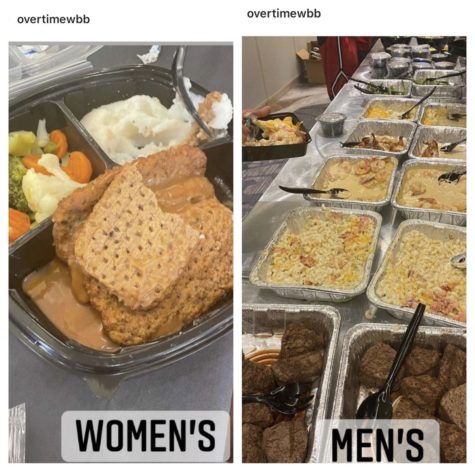Blatant sexism in sports evident in the differences in NCAA handling of men’s and women’s basketball tournament
For NCAA basketball fans, the March Madness that is the college basketball championship tournaments are the high holy days. That’s right, tournaments, as in two of them: the men’s and the women’s.
While getting the ESPN spotlight during tournament time, and probably only because CBS has the rights to the men’s tourney, the women get very little respect. And that lack of respect is even evident from the NCAA itself as the college athletics governing board came under fire this tournament season for its blatant gender discrimination while hosting its teams in the COVID-19 “bubble,” shedding an even brighter light on sexism in sports.
The men’s tournament was based in Indianapolis, while the women’s tournament was held in San Antonio. Each had its own committee to organize the events, including the lodging and facilities provided to the participating teams. But the public was outraged to see the disparities between the men’s and women’s respective facilities.
The most controversial difference called out by the women’s teams was in the weight rooms provided to the men and women. The men’s weight room was spacious and contained a plethora of equipment and weights. On the other hand, the women’s “weight room” consisted of a single rack of dumbbells, a stack of yoga mats, and an exercise bike.
The weight room disparity was initially criticized on social media by Stanford Performance Coach Ali Kerschner, who took to Instagram to call out the blatantly unfair difference between the two weight rooms. Kerschner’s post displayed a side-by-side of the two weight rooms, infuriating the public and exposing the sexism of the NCAA.
As the photos spread further across social media, the NCAA released a statement to excuse the clear disproportion between the men’s and women’s workout spaces, explaining, “In part, [the inequality of the weight rooms] is due to the limited space and the original plan was to expand the workout area once additional space was available later in the tournament.”
Oregon Ducks player Sedona Prince clapped back at the notion that “limited space” was the problem. She posted a video on TikTok (above) displaying the large, empty space beyond the team’s practice court, showing that if money was not an issue, then the NCAA could definitely make do with the abundant amount of space they had.
Other participants in the tournament joined in and posted their own photos and videos of the not-so-limited space their teams had, including Will Abrams, the Director of Player Development at Rutgers, and Kendric Lindsey, a digital content creator for the University of South Carolina women’s basketball team.
The social media uproar caught the attention of big-name athletes. Stephen Curry of the Golden State Warriors reposted Prince’s video on Twitter. The overall first pick in the 2020 WNBA Draft Sabrina Ionescu also took to Twitter, saying, “thought this was a joke. WTF is this?!? To all the women playing in the @marchmadness tournament, keep grinding!”

The weight room was not the only disparity between the treatment of the men and women in the NCAA bubble. The men were provided with larger portions of food, and the quality of their food was far better than that of the women’s as well. The “swag bags” gifted by the NCAA to all the players displayed a stark difference between what the men and women received.
One incredibly criticized disparity was the NCAA’s difference in COVID-19 testing. Many were surprised to find out that while the men’s tournament used polymerase chain reaction tests, the women’s tournament utilized rapid antigen tests.
Rapid antigen tests yield quick results, but “have a higher chance of missing an active infection,” according to the Food and Drug Administration. On the other hand, polymerase chain reaction tests are considered the “gold standard” because they are more accurate. Many were infuriated by the seemingly lesser concern for the women’s health and safety.
Mark Emmert, president of the NCAA, acknowledged the difference in COVID-19 testing between the men and women, but seemingly dismissed the dangers called out by social media of the women having a higher chance at having false negative tests.

“We have complete confidence in all medical protocols that have been put together,” said Emmert. “All of the health experts say the protocol that they’re using right now in all our venues and all our championships is one that has no difference at all in our ability to mitigate risk.”
As the criticism intensified, the NCAA finally attempted to move past all of the backlash and gave the women’s teams a proper weight room. The new and improved workout space included more weight racks, bands, treadmills and exercise bikes, and much more. Some believe that the proper workout space did not come soon enough, but many were grateful to have their voices heard.
Prince posted another video on TikTok expressing her and her team’s excitement for the new weight room. She thanked the NCAA for responding to the situation prior to the start of the tournament. “We appreciate y’all. Thank you so much for real,” Prince posted.
Despite this situation ending in a win for the women’s tournament, players and fans take notice of the blatant sexism that occurred in the NCAA March Madness bubble, calling back to the struggle for gender equality in all sports and professions. Gender inequality in sports has been ongoing for decades, but in a time where women are speaking out against sexism more than ever before, all eyes are on the NCAA as it moves forward and continues to represent all of its collegiate athletes equitably.










